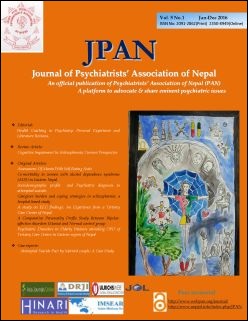A study on EEG findings: An Experience from a Tertiary Care Center of Nepal
DOI:
https://doi.org/10.3126/jpan.v5i1.18329Keywords:
Electroencephalogram, EEG Findings, Seizure, NepalAbstract
Introduction: The electroencephalography (EEG) is the recording of brain’s spontaneous electrical activity over a period of time (15-20) minutes recorded from multiple electrodes placed on the scalp. It is used in seizure disorder, organicity, and psychiatric conditions. There is a paucity of literature with regard to the application of EEG in various conditions in our setting.
Objective: The current study aims to explore the EEG findings of different cases and their associations in various clinical scenarios.
Method: It is a retrospective study on the patients who underwent EEG in the EEG room of Department of Psychiatry at Patan Academy of Health Sciences (PAHS), Nepal for a year. Information was obtained from EEG register and reports. Data were analyzed using IBM SPSS version 23. Frequency distribution was studied and Chi Square test was applied for categorical variables. The only continuous variable studied was the age for which mean, median and standard deviation were computed and the suitable statistical tool was applied after normality testing.
Result: Of the total 164 patients studied, mean age was 21.93 years and 51.2% were male. The common reason for EEG referral was to rule out seizure disorder (80.5%), requested mostly from the department of Psychiatry. EEG abnormality was seen in 43.3% with EEG diagnosis of generalized epilepsy in 26.21% and slow wave (46.2%) as the most common EEG finding. Abnormal EEG detection rate was almost similar in both the genders and predominant in those with a clinical diagnosis of seizure disorder (47.88%). The EEG abnormality detection rate was significant in those referred from the Department of Psychiatry and Paediatrics.
Conclusion: EEG is a relatively inexpensive and non-invasive test for detection of electrical activity in the brain. Though requested for seizure or related disorders, it can also find its place in organic pathology, monitoring treatment response among others.
Downloads
Downloads
Published
How to Cite
Issue
Section
License
This license enables reusers to distribute, remix, adapt, and build upon the material in any medium or format, so long as attribution is given to the creator. The license allows for commercial use.




